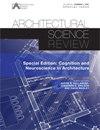算法乡土:山坡住区和住宅的生成设计过程,优化了选址、通道和预制建筑
IF 1.8
3区 艺术学
0 ARCHITECTURE
引用次数: 2
摘要
山坡上的住宅需要复杂的设计和施工技术,导致生产率低,成本高。城市山坡上通常有带有私人花园的低密度独立住宅,或者高密度的非正式定居点,缺乏绿色空间,不适合居住。相比之下,密集建造的历史小镇在旅游背景下因其环境和空间一致性而受到赞赏。本文提出了一种设计知识与参数化设计相结合的设计过程。本研究采用设计研究、计算机模拟和案例研究相结合的混合方法。基于住宅设计和制造/安装方面,开发了住宅模块的形状语法,并将其与基于规则的生成设计算法相结合。这个过程允许高密度住区的设计,包括低层住宅,以地形和系列建筑原则作为设计的动力。由此产生的两阶段参数化设计工具在惠灵顿(新西兰)的一个案例研究场地上进行了测试和完善。本文章由计算机程序翻译,如有差异,请以英文原文为准。
Algorithmic vernacular: a generative design process for hillside settlements and dwellings, optimized for siting, access and prefabricated construction
Dwellings on hillsides require complex design and construction techniques, resulting in low productivity and high cost. Urban hillsides often feature low-density individual houses with private gardens or high-density informal settlement with lack of green spaces and compromised liveability. By contrast, densely built historic hill-towns are admired in the context of tourism for their setting and spatial coherence. This article proposes a design process, which combines design knowledge and parametric design. The research employs a mixed methodology, combining design research, computer simulation, and case study. Based on dwelling design and aspects of fabrication/installation, a shape grammar of dwelling modules is developed, which are set-out and combined with a rule-based, generative design algorithm. The process allows for the design of high-density settlements, comprising low-rise dwellings, with topography and principles of serial construction as design generators. The resulting two-stage parametric design tool is tested and refined on a case-study site in Wellington (NZ).
求助全文
通过发布文献求助,成功后即可免费获取论文全文。
去求助
来源期刊

Architectural Science Review
ARCHITECTURE-
CiteScore
4.80
自引率
8.70%
发文量
34
期刊介绍:
Founded at the University of Sydney in 1958 by Professor Henry Cowan to promote continued professional development, Architectural Science Review presents a balanced collection of papers on a wide range of topics. From its first issue over 50 years ago the journal documents the profession’s interest in environmental issues, covering topics such as thermal comfort, lighting, and sustainable architecture, contributing to this extensive field of knowledge by seeking papers from a broad geographical area. The journal is supported by an international editorial advisory board of the leading international academics and its reputation has increased globally with individual and institutional subscribers and contributors from around the world. As a result, Architectural Science Review continues to be recognised as not only one of the first, but the leading journal devoted to architectural science, technology and the built environment. Architectural Science Review publishes original research papers, shorter research notes, and abstracts of PhD dissertations and theses in all areas of architectural science including: -building science and technology -environmental sustainability -structures and materials -audio and acoustics -illumination -thermal systems -building physics -building services -building climatology -building economics -ergonomics -history and theory of architectural science -the social sciences of architecture
 求助内容:
求助内容: 应助结果提醒方式:
应助结果提醒方式:


